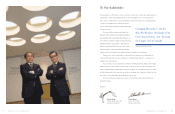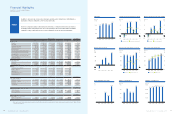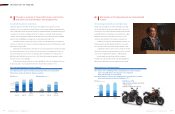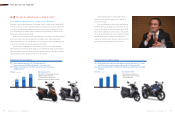Yamaha 2013 Annual Report Download - page 14
Download and view the complete annual report
Please find page 14 of the 2013 Yamaha annual report below. You can navigate through the pages in the report by either clicking on the pages listed below, or by using the keyword search tool below to find specific information within the annual report.
What progress was made in the area of management reforms during
2013?
We moved forward with global business restructuring and cost reductions.
The MTP identifies both increasing earnings strength and expansion of the business scale as equally important issues,
and we are building on the work begun under the previous MTP to restructure our developed markets business. We
have consolidated and realigned our domestic production structure to eight factories and 16 units as of the end of
2013, from 12 factories and 25 units at the end of 2009. We have also made progress in restructuring our business
organization in Europe.
In terms of cost reductions, our target for the three years from fiscal 2013 under the MTP is for ¥90.0 billion. We
are working toward this goal with market-specific design at our integrated development centers in ASEAN and India, and
at the same time we have reduced procurement costs for platform parts. As part of our strategy to build strategic
partnerships, we have set up a joint venture with KYB Corporation for the development and production of suspensions.
We will continue to pursue proactive cost reductions in 2014.
What is your long-term strategy?
We want to provide a growing world of personal mobility.
The Yamaha Motor Group is pursuing new business segments by introducing new
concepts in personal mobility. The exploration of a growing world of personal mobility
has led to an expansion of technologies and customers from two wheels to three and
to four, and we are positioning this as one part of our long-term development strategy
for new businesses.
In 2013, we developed the leaning multi-wheel TRICITY concept three-wheeled commuter, and we are working
toward a 2014 market launch. Further building on the multi-wheel concept, we are researching and developing the
small four-wheeled MOTIV, which we exhibited at the Tokyo Motor Show.
Going forward, we will pursue original and innovative concepts, technologies that achieve superior performance
and functionality, and design that expresses refined dynamism, incorporating Yamaha’s unique engineering,
manufacturing, and marketing, to vastly expand the world of personal mobility.
INTERVIEW WITH THE PRESIDENT
Q7Q6
Cost Reduction Strategies: “Change Global Manufacturing” Cost Reduction Strategies: “Expand Global Procurement and Supply”
Change drawings based on each market
Operate integrated development centers (for motorcycle)
Design products and draw up plans based on market quality standards
Cost down targets
Change the development process
Consolidate to PF and expand variations
Reduce the lead time for product development by 30%
GC: Golf Car
Europe
India
ASEAN
Taipei/Shanghai
U.S.
(RV/GC/WV)
Consolidate to PF
Scale effects in procurement and production
(Billion ¥)
2012 20172015
580
Procurement
amount
840
1,000
1,000
500
0
PF models
60%
40%
40%
60%
100%
(Billion ¥)
2012 (3 years) 2017 (5 years)2015 (3 years)
75
90
150
100
50
0
Net
cost reduction
Japan:
Develop basic PF
Integrated
development centers:
Develop variations
・
Localize the process of
drawing up plans
・
Increase the marketability
and modernity of products
Strengthen manufacturing competence
Gain “great technological strengths” and “outstanding
competence at factories”
Augment “mother” and “global” functions
Involve suppliers
Expand global procurement and supply
Streamline logistics
Overall review of logistics in procurement, production and sales
Reduce costs by ¥10 billion
Consolidate suppliers
Promote strategic collaborative activities
Reduce costs by 30% by consolidating to PF
(Billion ¥)
2012 2017
400
suppliers 580
380
200
suppliers
1,000
600
1,000
500
0
PF
common
parts
Global supply of parts
from procurement centers
(in 4 key regions)
Global supply of models
from the most suitable
production base
Complement of parts and
products within the regions
Consumption, production + supply
Consumption (production)
Procurement
logistics Sales logistics
CBU/CKD
logistics
Procurement
amount
Global
partners
2012 2015
100% quality
production process
Theoretical
value-based
production
28%
38%
74%
76%
Global achievement rates
Yamaha Motor Co., Ltd. ⎢ Annual Report 2013 Yamaha Motor Co., Ltd. ⎢ Annual Report 2013
24 25
























